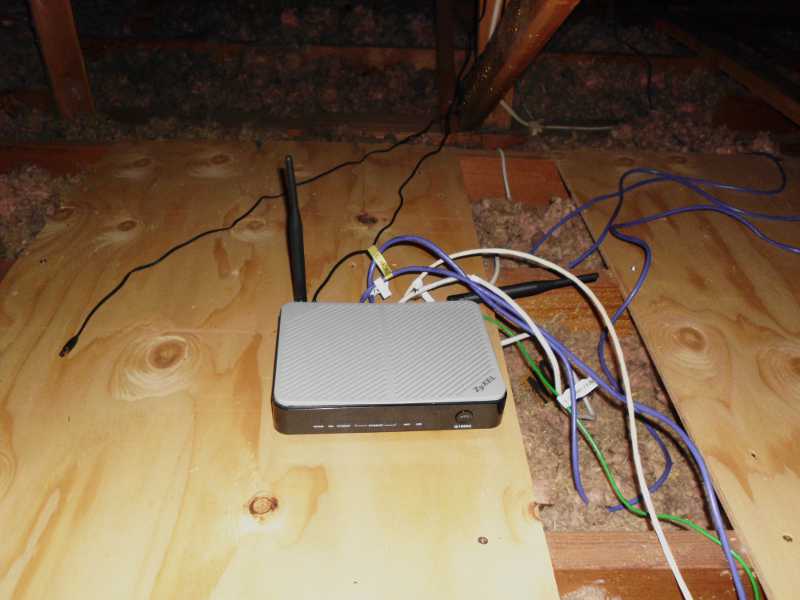
Update: this unit, which I got used on eBay, burned out its modem after 2 weeks in service, in an admittedly warm environment. The router and switch continued to work just fine. See note below about rumored thermal issue with this model.…what I thought was a burned out modem was just a loose phone wire. The unit is fine, and back in service, now.
We have the Fusion package (uncapped DSL internet and phone) from sonic.net . It was stable for almost 3 years, then just recently, the internet would disconnect, the DSL light on the modem would blink for a minute, then everything would come back fine. As a diagnostic measure, and because it wouldn’t hurt to have a spare modem around anyway, I bought a used ZyXEL Q-1000z for about $28 on eBay. The internet dropout turned out to be a loose phone wire, but here are my thoughts on the ZyXEL modem, just the same.
This modem/router device had apparently been used on CenturyLink (formerly Qwest). Their product numbering scheme seems to be as follows:
- Q = external antenna, C = internal antenna
- 1000 = gigabit ethernet interface, 100 = 100TX ethernet
- z = ZyXEL manufacturer, a = ActionTec manufacturer
The default broadband settings had a VPI (Virtual Path Identifier) and VCI (Virtual Circuit Identifier) of 0 and 32, respectively. These numbers, at least in part, identify whether the modem is to connect to the local internet provider. In the case of sonic.net Fusion (which is really AT&T U-verse) in San Jose, California, I needed VPI=0 and VCI=35, which were easy to set from the modem’s web interface at 192.168.0.1 . While the modem is purportedly capable of the VDSL protocol at 50 Mbps speeds, switching to VDSL would mean a service call, so I forced the protocol to ADSL2plus. In sum, here are the Broadband settings that worked:
- Transport Mode = ATM (would have to set to PTM to get VDSL2 option)
- Line Mode = ADSL2plus
- Encapsuation Type = LLC Bridged
- MTU Value = 1500
- ATM parameters -> UBR without PCR (Unspecified Bit Rate without Peak Cell Rate)
- ATM parameters -> PCR = 0 (n/a)
- ATM parameters -> SCR = 0 (n/a)
- ATM parameters -> MBS = 0 (n/a)
- VPI = 0 (varies by location)
- VCI = 35 (varies by location)
The modem connected easily to the internet, and we got some 18 Mbps, about the same as from the original Comtrend CT-5072T modem.
But the Q1000z was both a modem and router in one, with a 4-port gigabit switch, and 802.11 b/g/n wi-fi. So it replaced both our previous modem, and separate Belkin router.
Since I have a server in the house, I tried to forward incoming port 80 so I could show web pages. But when I tried to browse those pages from inside the house, I couldn’t reach them. I found that I couldn’t ping my own WAN address, either. Funny, those things had worked before with the discrete modem and router. At first, I thought that the ports were not being forwarded properly, but from outside the house, found that I could get to my server’s web pages just fine. A little research on the internet suggested that the router on the Q1000Z does not implement this thing called Reverse NAT.
Nothing I tried in router settings could fix the issue, but there was a workaround, at least on a per-computer basis. The server for my site, pididu.com, is on the internet at large at IP address 173.228.19.69. On my local network, however, it’s at address 192.168.2.101. What I could do was edit the hosts file on each computer in the house. For example, in the case of a computer with Windows XP, I could go to \windows\system32\drivers\etc\ , and add the following line to the file named hosts:
pididu.com 192.168.2.101
The result of doing so is to force browsers go straight to that address for pididu.com, rather than ask a DNS server somewhere for an address. It’s not nearly as good as a router that automatically does the right thing, but is good enough.
Other things I noticed:
- The power cord is only 3 or 4 feet long. That could be either a positive or negative.
- Firmware version QZZ001-4.4.015.1 is hard wired with the name Qwest in places.
- The box gets hot during normal operation, and there are rumors of thermal issues in a prolonged hot environment.
- The radio runs at 2.4 GHz. There is no 5 GHz like the previous Belkin router.
- The router has no guest network feature. I rarely used the feature on the old router, anyway.
- There is a USB port on the router, probably so that it can host pictures or streaming media. I didn’t test that feature.
- A QoS (Quality of Service) function is offered. Even if I don’t care about allocating certain bandwidth to certain addresses, enabling QoS gives a running status display of upload and download speeds. However, there seems to be a small speed penalty associated with QoS, so I think I’ll keep it off except for diagnostic purposes.
- There are two external antennas. The jack for one of them was loose when I first got the unit, so I tightened it with a wrench.
- Even after setting the wi-fi transmitter on the router at full power, the signal at the front of my house was 25%. That was quite enough for normal operation of the streaming DVD player, but the previous router, a Belkin N750, had a 34% signal in the same location. But since the Q1000z has external antennas, it theoretically could be possible to run co-ax cable from the antenna jack, and locate one or both antennas close to the location where a strong signal is needed.